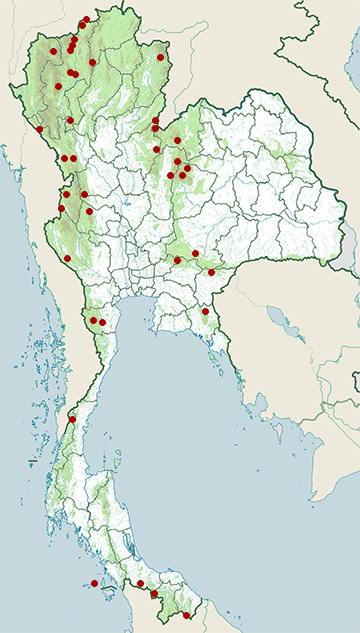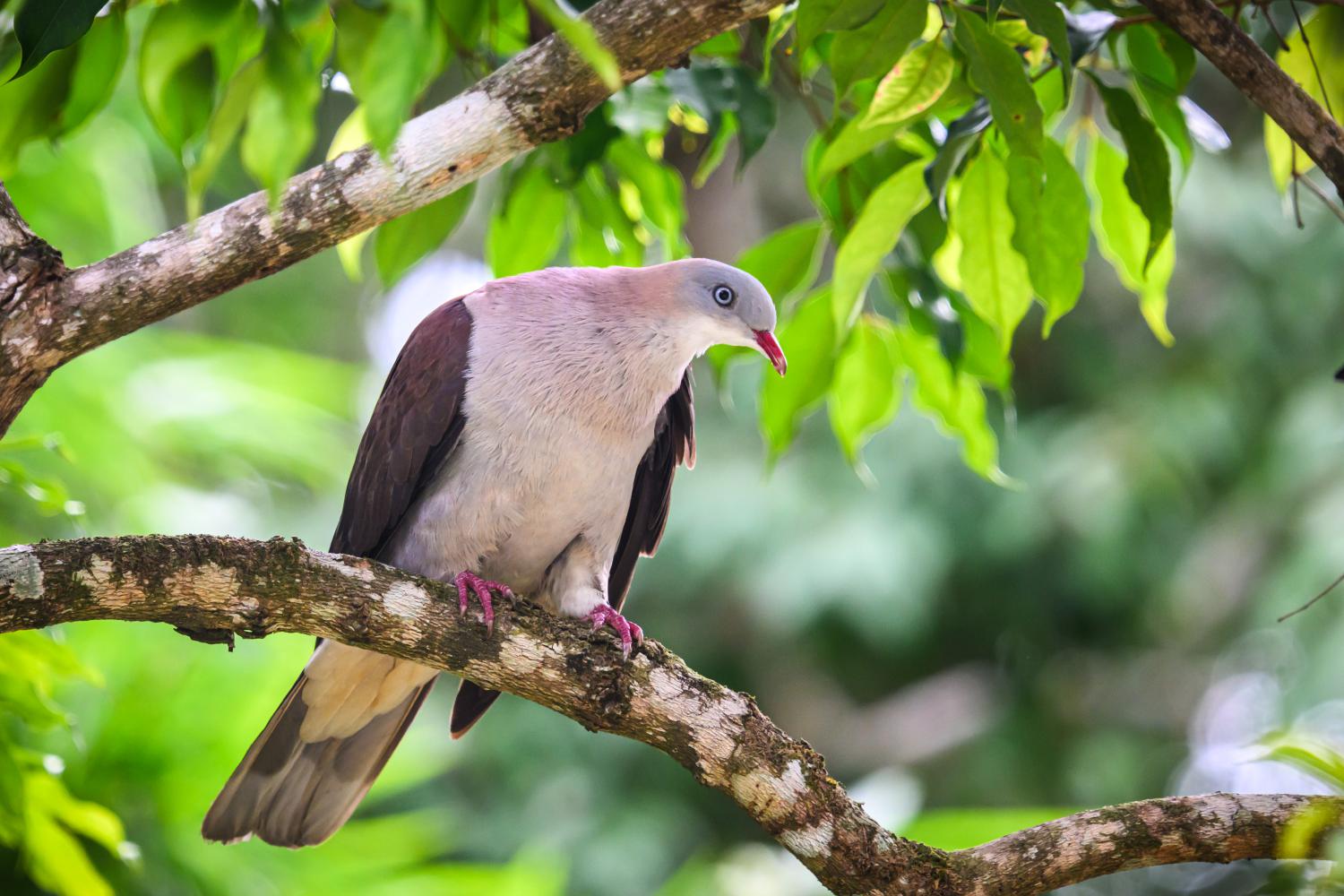Species of Thailand
Mountain imperial pigeon
Ducula badia
Thomas Stamford Raffles, 1822
In Thai: นกมูม
The mountain imperial pigeon (Ducula badia), also known as the maroon-backed imperial pigeon or Hodgson's imperial pigeon, is a species of bird in the pigeon and dove family with a wide range in south-eastern Asia.
Description
The mountain imperial pigeon is the largest pigeon species in its range at 43 - 51 cm long. It has a fairly long tail, broad, rounded wings and slow wing-beats. The head, neck and underparts are vinous-grey with a contrasting white throat and brownish-maroon upperparts and wings, though the upper part of the body can be duller. The underwing is slate-grey and the tail is blackish with a grey horizontal line. The combination the maroon back with the large size give this species a distinctive appearance. Its call consists of a deep, resonant boom that is only detectable at close range.
Behaviour
Though usually solitary, this species has been seen in groups numbering up to 20, especially when going to roost or flying up or down in mountains. They can be difficult to see, since they spend their time usually in high canopy and usually fly fairly high over the canopy.
Breeding
During the breeding display, calling birds puff up their throats considerably while singing and bow to potential mates. Then the displaying bird engages in a vertical flight up from the perch, up 6 to 8 m into the air, and then glide back down with wings and tail widely spread. In the Northern stretches of the species range, breeding is from March to August, while in the southern parts of India and southeast Asia, they breed from January to May. The nest is usually in a fairly small tree, about 5 to 8 m off the ground, and is a flimsy platform. One, or rarely two, eggs are laid and both parents incubate. They only leave the nest if highly pressed.
Feeding
They feed on fruits and berries, especially figs and nutmeg, which are plucked and swallowed whole. They will occasionally go to the ground to drink, as in Bornean mangroves where up to 200 or 300 of these pigeons have been flushed at once. There may be a partial altitudinal movement in some parts of their range, in pursuit of ideal feeding conditions.
Distribution and habitat
The pigeon has a wide range in south-eastern Asia, where it occurs in Bangladesh, Bhutan, Brunei, Cambodia, China, India, Indonesia, Laos, Malaysia, Myanmar, Nepal, Thailand, and Vietnam. Its natural habitats are subtropical or tropical moist lowland forests, subtropical or tropical mangrove forests, and subtropical or tropical moist montane forests. It may be found from sea level to elevations of 2550 m in the Himalayas and 2200 m on Sumatra. Being mainly a foothill bird, it probably only breeds above an elevation of 500 m, although feeding flocks below this are common. It is usually found in old-growth forests. The species is generally fairly common where extensive stands of forest remain.
This article uses material from Wikipedia released under the Creative Commons Attribution-Share-Alike Licence 3.0. Eventual photos shown in this page may or may not be from Wikipedia, please see the license details for photos in photo by-lines.
Category / Seasonal Status
BCST Category: Recorded in an apparently wild state within the last 50 years
BCST Seasonal status: Resident or presumed resident
Scientific classification
- Kingdom
- Animalia
- Phylum
- Chordata
- Class
- Aves
- Order
- Columbiformes
- Family
- Columbidae
- Genus
- Ducula
- Species
- Ducula badia
Common names
- Thai: นกมูม
Conservation status

Least Concern (IUCN3.1)
Photos
Please help us review the bird photos if wrong ones are used. We can be reached via our contact us page.
Range Map

- Chiang Dao District, Chiang Mai
- Chiang Dao Wildlife Sanctuary
- Doi Inthanon National Park
- Doi Lang
- Doi Pha Hom Pok National Park
- Doi Phu Kha National Park
- Doi Suthep - Pui National Park
- Hala-Bala Wildlife Sanctuary
- Huai Kha Khaeng Wildlife Sanctuary
- Kaeng Krachan District, Phetchaburi
- Kaeng Krachan National Park
- Khao Nam Khang National Park
- Khao Soi Dao Wildlife Sanctuary
- Khao Yai National Park
- Khon San District, Chaiyaphum
- Khun Chae National Park
- Kromluang Chumphon Wildlife Sanctuary
- Mae Moei National Park
- Mae Ping National Park
- Mae Sot District, Tak
- Mae Wong National Park
- Mueang Chiang Mai District, Chiang Mai
- Nam Nao National Park
- Pai District, Mae Hong Son
- Pang Sida National Park
- Pha Daeng National Park
- Phu Hin Rong Kla National Park
- Phu Khiao Wildlife Sanctuary
- Phu Luang Wildlife Sanctuary
- Phu Soi Dao National Park
- Phu Suan Sai National Park
- Sai Yok National Park
- Sakaerat Environmental Research Station
- San Kala Khiri National Park
- Taksin Maharat National Park
- Tarutao National Marine Park
- Tat Mok National Park
- Thung Yai Naresuan Wildlife Sanctuary
- Umphang Wildlife Sanctuary

